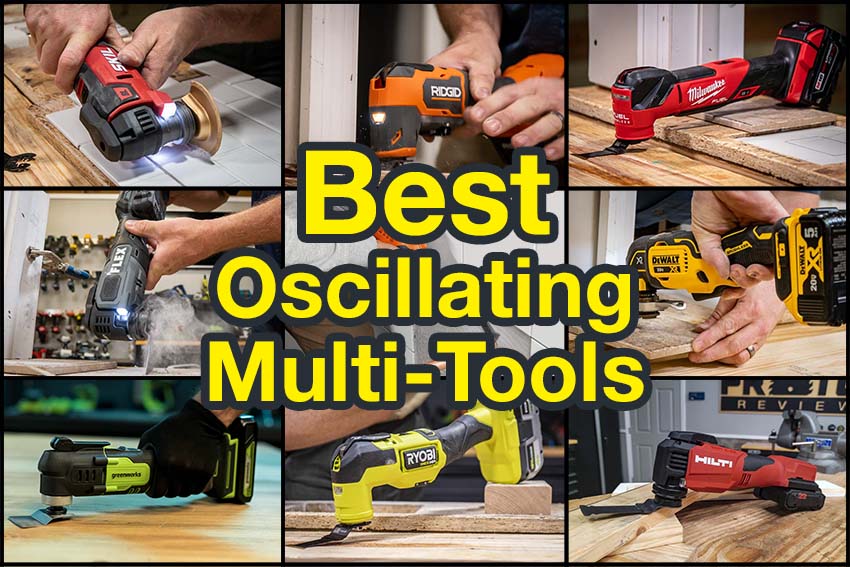Choosing the best oscillating multi-tool used to boil down to just a couple of brands. Not anymore. Advancements in battery, motor, and vibration control technologies offer more viable options than ever. Couple that with new solutions featuring hands-free Starlock accessories, and you double your choices. The oscillating multi-tools of today feature easier-to-use tool-free accessories, lower vibration, and more power. Couple that with vastly-improved accessories and carbide tooth blades, and you have tools that can do far more than ever before.
As we tested and considered the landscape of tools, our crew was unanimous in its selection of the best cordless oscillating multi-tools. Corded models are absolutely relevant; they’re less expensive, and there are some outstanding options available. However, when we laid out the requirements of earning the “best” label, everyone enjoyed the convenience of battery power.
Our Best Oscillating Multi-Tool Top Picks
- Best Overall: Milwaukee M18 Fuel 2836
↓ Jump to this Tool - Best Vibration Control: Makita 18V LXT XMT04
↓ Jump to this Tool - Best for the Money: Flex 24V FX4111
↓ Jump to this Tool - Best on a Budget: Skil PWRCore 20 OS5937-10
↓ Jump to this Tool - Best Corded: Fein MultiMaster MM 700
↓ Jump to this Tool - Best Blade Change System: Starlock
↓ Jump to this Tool
Best Oscillating Multi-Tool Overall
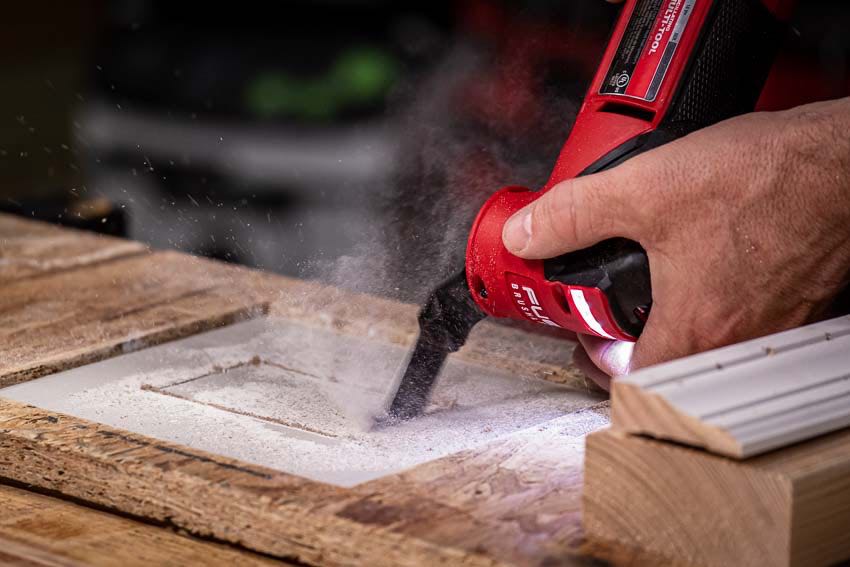
Milwaukee M18 Fuel 2836
- Style: Open-Lok
- Max OPM: 20,000
- Oscillation Angle: 4.2°
- Variable speed: Dial
- Warranty: 5 years
Let’s clear the air here—if cutting speed is your highest priority, there’s Milwaukee, and then there’s everyone else. Make your first cut, and you’ll see that Milwaukee’s M18 Fuel oscillating multi-tool is way ahead of the competition. Plus, there’s very little vibration while cutting.
Combined with the physical design, the overall control of the tool is better. The head of the tool features an overmold that serves as a perfect rest for your hand. It makes cutting even faster because it helps you reduce mistakes and better guide the blade. For detail sanding, grab the Milwaukee M12 detail sander, but for plunge-cutting and everything that makes an oscillating multi-tool and essential product, the 2836 knocks it out of the parkl.
While Milwaukee’s performance topped the charts in my testing, it’s not a complete runaway. This model still uses the slower Open-Lok accessory change system. The Starlock system is far better and might be enough to push you to another choice if you’re not already locked into the M18 system of batteries. Overall, however, this tool hits all the marks and presents the most well-rounded high-performance tool we’ve tested.
Reasons to Buy
- Fast, powerful cutting
- Low vibration
- Excellent visibility
Consider Another Model If You
- Want hands-free Starlock blade changes
- Need a more budget-minded solution
Best Oscillating Multi-Tool for Vibration Control

Makita 18V LXT Sub-Compact XMT04
- Style: Starlock Max
- Max OPM: 20,000
- Oscillation Angle: 3.6°
- Variable speed: Dial
- Warranty: 3 years
Makita’s latest generation multi-tool features some outstanding improvements in vibration control. The XMT04 stood out in our testing with lower vibration than the rest. The sub-compact Makita XMT04 replaces the Makita XMT03, which had been in need of an upgrade. When I started cutting and sanding with the XMT04, the difference from the former model was astounding.
Makita absolutely nailed vibration control in this model, dropping to levels that beat all its competitors. At the same time, cutting and sanding speed increased significantly. To top it all off, this model has a Starlock Max interface, which I love—though it still features a pin that holds the blade in place. That makes it not quite hands-free but better than the older model it replaces.
Sanding, undercutting, and even clipping metal bolts went smoothly and quickly using our test blades. It also quickly removed grout, and the larger head helped it excel at sanding tasks (not our favorite use for a multi-tool).
Reasons to Buy
- Absolute lowest vibration
- Quick, powerful cutting
Consider Another Model If You
- Need a lighter, more portable saw
- Want a less bulky head
Best Oscillating Multi-Tool for the Money
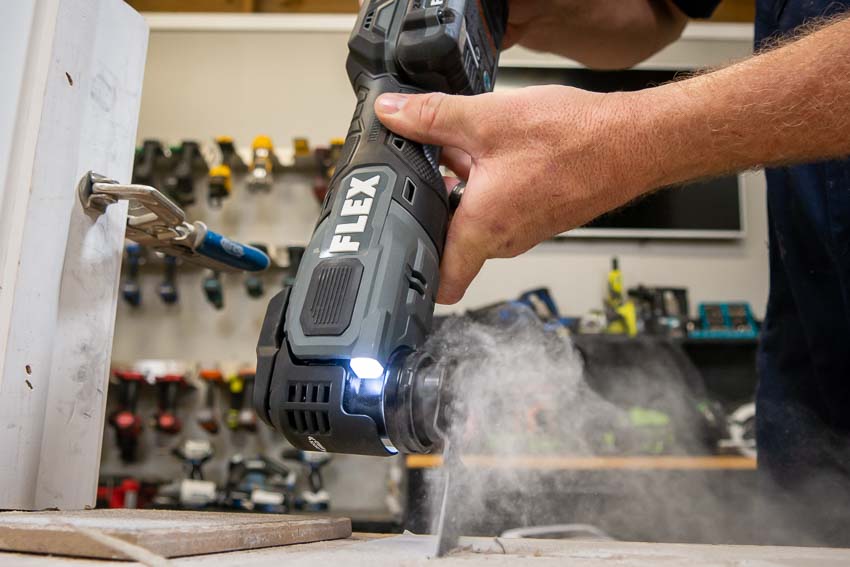
Flex 24V Brushless FX4111-1A
- Style: Starlock
- Max OPM: 20,000
- Oscillation Angle: 4.0°
- Variable speed: Pushbutton w/LED
- Warranty: Lifetime (if registered)
Flex brings a legit Pro-level cordless oscillating multi-tool to the table with performance and design that I didn’t expect from a first-generation tool. It was one of the fastest cutting in our tests and has five electronic speeds to choose from. Its isolated head design does a nice job reducing vibration, though it’s not as low as Fein, Makita, and Milwaukee.
The tool’s ergonomics are excellent, too. It has a slimmer handle than many, with an overmold that promotes a secure and comfortable grip. Add to that a Starlock hands-free accessory interface, and you get a compelling package.
Possibly the best part is the price. For $199, you get the tool, a 2.5Ah battery, and a fast charger, making it our best-value pick for Pros.
Reasons to Buy
- Starlock interface
- Low kit price
- Excellent performance
- Reasonably low vibration
Consider Another Model If You
- Want the absolute lowest vibration possible
- Prefer a lighter weight tool
Best Budget Oscillating Multi-Tool
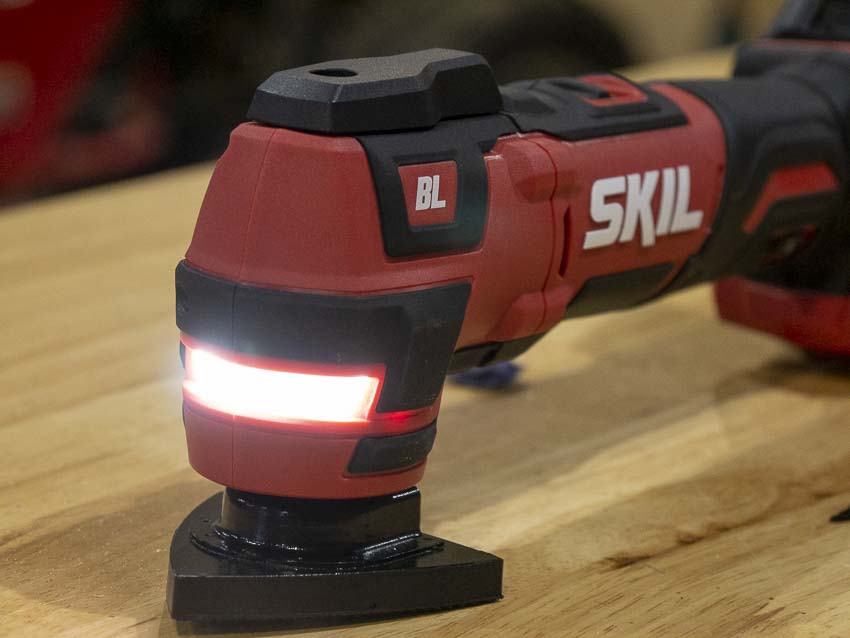
Skil PWRCore 12 Brushless OS592702
- Style: OIS quick-release
- Max OPM: 18,000
- Oscillation Angle: 3.6°
- Variable speed: Dial
- Warranty: 5-year limited
Skil’s PWRCore 12 oscillating multi-tool is a solid value if you’re looking for a brushless package on a budget. For just under $100, you get a brushless tool with a 2.0Ah battery, an upgraded PWRJump charger, and a nice blade/sanding set to get you started. Even though it doesn’t have the performance level of the stronger PWRCore 20 brushless model, the price is right, and it’s a lighter package than most of the 18V/20V max models.
In real-world use, the tool presents acceptable vibration. You can spend more and get a more powerful model with less vibration. However, the Skil OS592702 strikes a critical balance. It cut through both wood and finish nails with reasonable speed. Its performance in thicker 1/4-inch bolts took longer, but it got the job done. This is an easy choice for those looking to pick up a tool for occasional use.
Reasons to Buy
- Tool-free blade changes
- Really low kit price
- Acceptable performance for the money
Consider Another Model If You
- Want Starlock
- Prefer less vibration
- Need longer runtime or more power
Best Corded Oscillating Multi-Tool

Fein MultiMaster MM 700 Series
- Style: Starlock
- Max OPM: 19,500
- Oscillation Angle: 3.4°–4.0°
- Variable speed: Dial
- Warranty: 3-year limited
While I greatly prefer cordless OMTs, I can certainly acknowledge that corded models still play a huge role in this sector. If that’s what you’re after, there isn’t a more capable and versatile oscillating multi-tool than the Fein MultiMaster MM 700 series.
Fein set the benchmark for vibration control with the MultiMaster line, and it’s taken many years for anyone to come even close. While there’s certainly competition, MultiMaster OMTs are still outstanding in this category. The line has three key products—the MM 300, 500, and 700 models. The MM 700 line represents the best possible performance for the MultiMaster line.
Fein also offers particular accessories and oscillating angles specifically for construction, caulking/concrete, and automotive applications. That means that, regardless of your desired use, Fein is better equipped than most to offer a solution that better optimizes your tool for the application. While most manufacturers offer a single oscilating multi-tool, Fein offers an entire suite of products for you to choose from.
Best Oscillating Multi-Tool Blade Change System
Starlock (Multiple Brands and Models)
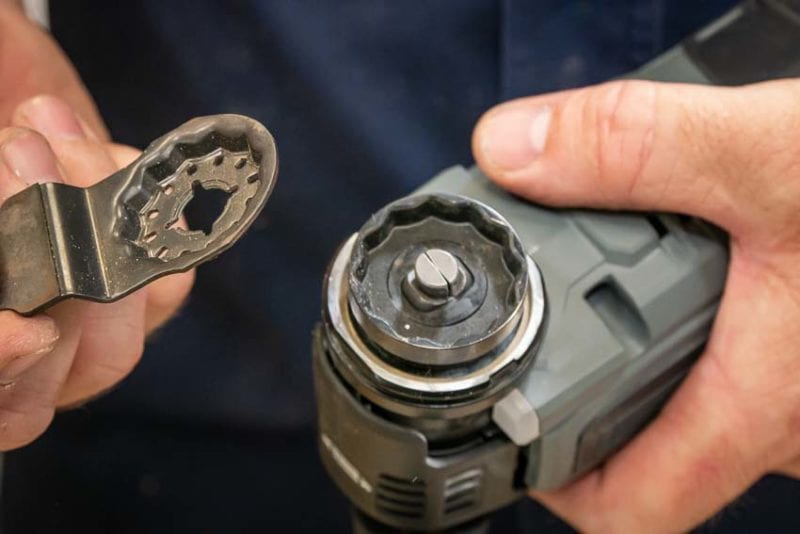
There were no surprises in our blade change evaluation, as Starlock still dominates in speed and ease. Simply pressing the interface into the blade snaps the lock on it, and you’re ready to go. When it’s time to change it out, the release ejects it from the tool without any additional help.
Bosch and Fein collaborated to create the Starlock interface and use it extensively. We also see it on the Festool Vecturo, Flex 24V oscillating multi-tool, and Makita 18V Sub-Compact multi-tools.
Even though Starlock has a significant advantage, Craftsman and DeWalt have a clamping-style interface that’s also very easy to use with slotted OIS accessories.
Also in this Article
- Why You Can Trust Pro Tool Reviews
- What We Look for When Buying an Oscillating Multi-Tool
- More Recommendations from Brands We Trust
- Best Oscillating Multi-Tool Blades
- What is an Oscillating Multi-Tool Used For?
Why You Can Trust Pro Tool Reviews
Pro Tool Reviews has been reviewing tools and reporting on industry news in the construction, automotive, and landscaping industries since 2008. Our Pro reviewers work and have extensive experience in the trades and have the skills and knowledge to know whether tools can perform well in the field.
I won’t recommend anything unless I’d use it myself and don’t really care who the primary retailer is. It’s all about giving you a legitimate recommendation and my honest opinion of each product.
Each year, we bring in and review hundreds of tools and accessories. Our team will put our hands on hundreds of additional tools at media events and trade shows throughout the year.
We consult with innovators in the technology and design of tools to gain a broader grasp of where these products fit and how they work. The result is information you can trust because of the editorial, scientific, and real-world professional experience we collectively utilize each and every time we pick up and test a tool.
What We Look for in Oscillating Multi-Tools – How We Test
Everyone has different priorities when searching for the best oscillating multi-tool. Some Pros just want the fastest performance, while others might value vibration control the highest. Regardless, my team and I look for the following features and rate tools accordingly.
Cutting and Sanding Speed
To test speed, our team compares how quickly we can cut wood, drywall, and nails. We also test the speed of removing a section of grout. Lastly, we sand a marked area until the markings are removed. To keep everything consistent, we use the exact same blades (brand new) between different tools.
The oscillating angle also contributes to speed. Fein is one of the only companies offering different solutions for differing applications. That means you can get one oscillating angle for automotive applications and another for construction applications. A larger angle cuts through wood more quickly, but may slow you down or dramatically increase vibration when cutting through metal.
Vibration Control
Vibration control has been dominated by Fein for a long time. Their technology has been so far ahead of everyone else that it hasn’t been competitive at all. That’s all changing, though.
As we test speed, we build our first impressions of each tool’s vibration control. Then, our three-man testing team spends time cutting and sanding to rank them into groups and assign their final scores.The best designs combine a decoupling of the power head with a well-designed cushioned grip, and in some cases, a separate mechanical vibration reduction system.
Ergonomics
When we consider the best oscillating multi-tool ergonomics, we start with weight. Cordless models tend to be heavier than corded tools. Working with a compact battery (such as with 12V tools) can reduce this somewhat.
Length can get in the way if you’re working in tighter spaces, so we measure that as well.
Our team also considers the handle design. Most use a grinder-style barrel grip with varying diameters. A design that feels good in the hand is great. However, I also check how it feels as I use the tool in the variety of angles I often have to use when going from one task to another. I also want to know how the tool works when using gloved hands.
There’s also the issue of how the battery connects to the tool. If it gets in the way of your grip or forces you to adjust your angle of attack into a cut, it can be a pain point. We prefer battery connections that power the tools without throwing off the balance of the tool or forcing a change in your grip.
Blade Change
Starlock set a new bar for oscillating multi-tools a few years ago with a completely hands-free and super-fast blade change. No other system comes close to its speed and convenience.
For the rest of the group, several versions of tool-free changes exist. We work with them all to see how securely they hold the blade and how convenient and quickly each facilitates blade changes.
While it works for some folks, we generally avoid models that require a tool to change the blade.
Value
Your bank account might fund your tool purchases, but it’s finite. You want the most bang for your buck. Value is much more than just how much the multi-tool costs. It’s what you get for the money. In that sense, some tools give you more value than others. Our team weighs pricing against the performance and design of each model to calculate a Value score.
Additional Features to Look For
- Max oscillating angle
- Variable speeds
- Brushless motor
More Recommendations from Brands We Trust
Bosch 18V Brushless GOP18V-34N
Bosch was part of the team that developed the Stalock system, so it’s no surprise our favorite Bosch model features it. With both 12V and 18V models available, it’s the higher performance of the 18V system that we’re drawn to in this case.
The newest version steps up in speed with a 3.4° oscillating angle, up from the 2.8° swing on the previous model. The top end of the oscillating rate remains the same with an adjustable 10000 – 20000 OPM, but the arc swing alone promises significant improvement in cutting and sanding speed. Bosch also turned the battery interface 90°, so you should have an easier time making those flush cuts.
Price: $159.00 bare tool
DeWalt 20V XR Oscillating Multi-Tool DCS356
Even though the performance is better, the physical design didn’t change much. The handle fits comfortably in your hand and the variable speed paddle trigger gives you control over both the speed and grip location.
Between this model, the 20V Max Atomic, and the 12V brushless, we still prefer the DCS356. It has three speeds instead of one and a higher top-end speed.
Price: $169.00 bare, $229.00 kit with a 2.0Ah battery and charger
Festool 18V Vecturo Oscillating Multi-Tool OSC 18
When Festool made a cordless version of the Vecturo multi-tool, the product team made a great move by shifting from a proprietary accessory interface to StarlockMax. The rest is classic Festool. As we expect from Festool, this is a highly refined system that goes beyond the tool. It starts with an ergonomically sound physical design with the performance and life of a brushless motor.
From there, you have accessories for dust collection, precise positioning, a depth stop, and the OSC-A adapter that they connect to.
Price: $399.00 bare, $635.00 with accessories, $799.00 with accessories and batteries (2 x 4.0Ah)
Hilti 22V Nuron Oscillating Multi-Tool SMT 6-22
If you’re familiar with the Hilti Nuron lineup, you might be satisfied just to know that Hilti has a cordless oscillating multi-tool in the lineup now. However, Hilti wasn’t satisfied with simply delivering a me-too product. The SMT 6-22 comes out of the gate hot, with a 10000 – 20000 six-mode electronic speed selection and an aggressive 4.0° arc.
Better yet, its isolated head design does a fantastic job of isolating vibration. While it’s not quite at the top for vibration control, it’s close. Plus, this model has a Starlock Max-compatible interface. If you’re on the HIlti Nuron platform and need an OMT, there’s no reason to look to other brands for a cordless model.
Price: $219.00 bare
Kobalt 24V Oscillating Multi-Tool KMT 224B-03
Lowe’s has an update to Kobalt’s cordless model with some changes worth considering. It’s still brushless, but the top speed downshifts from 20,000 OPM on the previous model to 18,000 OPM on this one. Speed control shifts from a speed dial to an electronic 3-speed switch and variable speed trigger plus a loc-on button. The oscillating angle remains at 3.6°.
So if the top speed is down, why buy this instead of the previous model? Vibration control. It’s significantly better in this model and well worth a little lower top speed to get.
Price: $99.00 bare, $149.00 kit with a 1.5Ah battery and charger
Metabo HPT 18V Oscillating Multi-Tool CV18DBLQ5
Metabo HPT has a few noteworthy items on their CV18DBLQ5 brushless oscillating multi-tool. Using the variable speed dial, you can set the speed from 6000 to 20000 OPM, giving you a lower slow speed than most when you need the best control. There’s also an auto mode that adjusts the speed based on the load the tool senses. The downside is that its 3.2° oscillating angle makes the cutting a little slower than some of its competition.
This is the only cordless model currently in the lineup and it’s an 18V tool, so it’s compatible with both 18V and 36V MultiVolt batteries, but not the AC adapter. Keep in mind Metabo HPT backs this and other lithium-ion tools with a lifetime warranty.
Price: $84.00
Ridgid 18V Oscillating Multi-Tool R86240
With the latest generation of 18V tools, Ridgid is breaking away from the larger size of Octane for more compact, lighter models. In the case of the R86240 oscillating multi-tool, it’s a break away from the JobMax system as well. The latest multi-tool is just 2.0 pounds without a battery and 3.0 pounds with a 2.0Ah Max Output pack.
Controlled with a slide switch and variable speed dial, the tool’s 10000 – 20000 OPM and 3.6° oscillating angle are on par with what we expect. While the physical design is a change from the ergonomics of the JobMax, Ridgid keeps the pivoting accessory interface that we’d love to see change into something else in the future.
As we’re writing, the kit comes with a pair of 4.0Ah batteries and is less than buying a two-pack of those batteries by themselves.
Price: $129.00 bare, multiple kit options available
Craftsman V20 Oscillating Multi-Tool RP CMCE565
Craftsman’s latest cordless multi-tool is very different from its predecessor. While it maintains the same basic form factor, slim handle, and clamping accessory system, there are some big upgrades.
The first is that as part of the Brushless RP system, it now sports a brushless motor and is capable of 19,000 OPM. That’s lower than the 22,000 OPM top speed of the CMCE501, but the brushless motor offers more power to keep the tool from bogging down. Another big change is that it changes from a slide switch and speed dial to a variable speed trigger.
Overall, this is a significant step forward for Craftsman’s oscillating multi-tool game.
Price: $99.00 bare
Ryobi 18V One+ HP Oscillating Multi-Tool PBLMT51
Ryobi’s 18V HP Brushless upgrade made its way onto the PBLMT51 oscillating multi-tool, making it a more legitimate Prosumer option than before. It has a slender handle profile that angles up to make sure the battery doesn’t get in the way of your flush cutting.
In its second generation, it retains the same 10000 – 20000 OPM speed as before but gains cutting speed thanks to an increase to a 3.8° oscillating angle. It also has a tool-free accessory interface instead of the hex wrench style the P343 had. Overall, it’s a huge step forward from the pre-HP Brushless efforts.
Price: $119.00 bare
Best Oscillating Multi-Tool Blades
CMT Orange Tools OMT Blades and Accessories
CMT Orange Tools has a wide range of oscillating multi-tool blades that covers both standard and Starlock interfaces, and nearly every application you can hope to tackle. Whether you’re working with wood, metal, multiple materials, or masonry, we highly recommend taking a look at what CMT Orange Tools has to offer.
What is an Oscillating Multi-Tool Used For?
Oscillating multi-tools take care of some of the most awkward cuts that other power tools can’t make. With the blade extending below the housing, it can make true flush cuts for trimming baseboards on flooring installation, trimming exposed conduit in electrical boxes, and many others.
Because you can also install the blade at a wide variety of angles, an OMT can also make cuts in awkward spaces where other saws can’t reach or might damage surrounding material.
By switching out for a sanding pad, they make highly effective detail sanders, though they don’t remove material as efficiently as dedicated orbital or belt sanders.
As you look around at the available accessories, you’ll find many more applications as well. You can remove grout, sealant, and caulk, as well as scrape adhesive and cut through many materials such as wood, metal, PVC, PEX, drywall, cement board/Hardieboard, and more.

